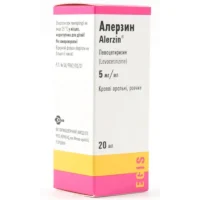Description
Allergodyl (Azelastine Hydrochloride) Nasal Spray 10 ml
Ingredients
Active ingredient: Azelastine hydrochloride
Mechanism of Action
Azelastine hydrochloride is a potent, selective antagonist of histamine H1 receptors. It exerts its effect by inhibiting the release of histamine and other mediators from cells involved in the allergic response, thereby reducing symptoms such as nasal congestion, sneezing, and itching.
Pharmacological Properties
Azelastine hydrochloride acts as a histamine H1 receptor antagonist, effectively reducing allergic symptoms by blocking the action of histamine. It also inhibits the release of inflammatory mediators, contributing to its anti-allergic properties.
Indications for Use
Indicated for the relief of symptoms of seasonal allergic rhinitis and perennial allergic rhinitis.
Contraindications
Do not use Allergodyl nasal spray if you are allergic to azelastine hydrochloride or any other ingredients in the product.
Side Effects
Common side effects may include a bitter taste, headache, or nasal irritation. If you experience any severe or persistent side effects, consult your healthcare provider.
Usage Instructions
Shake the nasal spray well before each use. Gently blow your nose before using the spray. Insert the tip of the spray into one nostril while closing the other nostril. Press down on the pump to release the spray. The usual dosage is 1 or 2 sprays in each nostril twice daily, or as directed by your healthcare provider.
Benefits Compared to Analogues
Allergodyl nasal spray has been clinically proven to provide significant relief from nasal symptoms associated with allergic rhinitis. Compared to placebo, studies have shown that azelastine nasal spray effectively improves nasal congestion and rhinorrhea, enhancing the quality of life for patients suffering from allergic rhinitis.
Suitable Patient Groups
Allergodyl nasal spray is suitable for adults and children over a certain age as determined by their healthcare provider. It is also safe for use in the elderly population, with appropriate monitoring for any potential side effects or interactions with other medications.
Storage and Shelf Life
- Storage: Store the nasal spray at room temperature away from moisture and heat.
- Shelf Life: Check the product packaging for the expiration date and do not use the nasal spray beyond that date.
Packaging Description
Allergodyl nasal spray is packaged in a 10 ml container designed for convenient and accurate dosing. The packaging is tamper-evident to ensure product integrity and safety.





